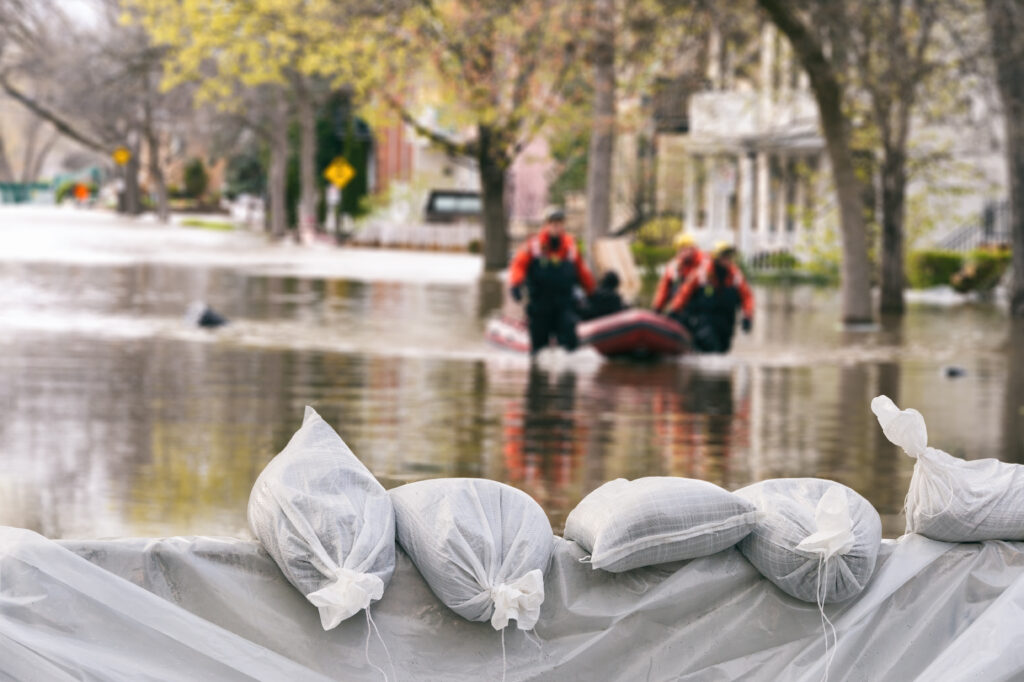Rising temperatures that result from climate change are contributing to widespread changes in weather patterns across the U.S. and broader world. Extreme weather events are happening more frequently and are increasing in severity. While scientists continue to uncover the direct link between climate change and changing weather patterns, what we have experienced in recent years includes hotter heat waves, bigger storm surges, catastrophic flooding, greater snowfall, and drier droughts.
This year alone, we experienced the hottest month on record (July 2023), a record number of atmospheric rivers in the West, unusual tornadic activity in the middle of the country, and compromised air quality from wildfires. And while the Atlantic hurricane season has been quiet so far this year, we are entering the most active months for hurricane activity.
We focus this blog on the connection between climate change and catastrophic flooding. As a California-based firm, we have witnessed first-hand the devastating impacts that the atmospheric river storms had throughout the state between October 2022 and March 2023. While atmospheric rivers are traditionally beneficial for the west to support building water supply and reducing chance of drought, they can also be disastrous when too much precipitation over a short period of time leads to flooding.
The Rising Costs of Floods
Scripps Institution of Oceanography at UC San Diego conducted a study last year that indicates that damages from flooding provoked by atmospheric river storms may triple, increasing from approximately $1B per year to $3B per year by the end of the century. This will include a 10% increase in atmospheric river-related flood damage each decade until the 2050s, where an even steeper curve may occur. This is attributable to atmospheric rivers holding and moving more water vapor as a result of a warmer atmosphere.
Those startling statistics are just the beginning. Atmospheric rivers are not the only contributors to catastrophic flooding, and flooding is historically the most costly and common natural disaster in the U.S. Thus, it is critical that jurisdictions across the U.S. are undertaking comprehensive resilience planning to safeguard communities and infrastructure. Beyond reductions to global greenhouse gas emissions, some ways in which projected damages from floods caused by various weather systems can be reduced include:
- Investments in flood protection infrastructure such as levees, seawalls, nature-based solutions, flood management tools, flood-proof buildings, etc.
- Land use planning to restrict development within flood-prone areas.
- Participation in the Community Rating System.
- Continued strengthening of federal, state, and local emergency management and emergency response programs through implementation of early warning systems and emergency preparedness, response, and recovery coordination.
- Individual actions taken by residents to make homes flood-resistant, such as elevated utilities and increased drainage.
Funding Assistance
Funding continues to be increased to support states, local jurisdictions, tribes, and territories at risk of repeat flood damage as the threat pervades.
Notably, President Biden’s Bipartisan Infrastructure Law (BIL) is designed to implement investments that increase our infrastructure’s resilience. The Law provides $3.5B for FEMA’s Flood Mitigation Assistance program, which is an increase from $150-200M per year that was available prior to the BIL. We outline other sources of potential funding below:
- FEMA – Flood Mitigation Assistance Grant Program, Building Resilient Infrastructure and Communities (BRIC) Program, and Hazard Mitigation Grant Program.
- EPA – Environmental Education Grants Program and Disaster Supplemental Funding.
- National Fish and Wildlife Foundation – National Coastal Resilience Fund.
- U.S. Army Corps of Engineers – Floodplain Management Services Program.
- State of California – Flood Emergency Response Project grants, Cal OES Hazard Mitigation Grants, Urban Flood Risk Reduction Program, and Small Communities Flood Risk Reduction.
- Your state – Check out your state’s Office of Emergency Management/Emergency Services for available state level funding.
- More funding for flooding can be located on the American Flood Coalition’s Flood Funding Finder.
Communication with the Public
With flooding being a pervasive and year-long threat in the U.S., residents should be aware of the risks of flooding – and not just when a flood is expected to occur or is occurring, but year-round. This involves consistent communication regarding flood safety and preparedness best practices. For a jurisdiction to move the needle toward resiliency, a whole community effort is required.
Resources available to assist your community in communicating and addressing flood risk and mitigation, particularly for the public, include:
- FEMA has crafted a Flood Communication Toolkit for Community Officials that includes presentations and talking points, social media content, writing materials, videos, and more.
- The Wharton School within the University of Pennsylvania explored best practices for communicating flood risk within a digital dialogue. The dialogue reinforces use of multi-modal risk communications methodologies, argues that property-level risk communication should be adopted as opposed to zones, emphasizes the importance of communications with youth who will inherit the challenges and burdens of floods, and highlights the importance of using impact-based communication rather than probability-based communication.
Conclusion
Catastrophic flooding is not going away, and by most
accounts, is expected to strengthen in frequency and severity. As such, action needs to be taken at all levels of government, in the private sector, and by the public to implement flood-resilient solutions, prepare for catastrophic incidents, and raise awareness.
Contact Us
Look for continued tips and blogs from the CONSTANT team. If
you need help with hazard mitigation planning, communications campaigns, or after action reporting, we’ve got you! Email us at: staff@constantassociates.com to discuss how CONSTANT can help your organization or jurisdiction.

